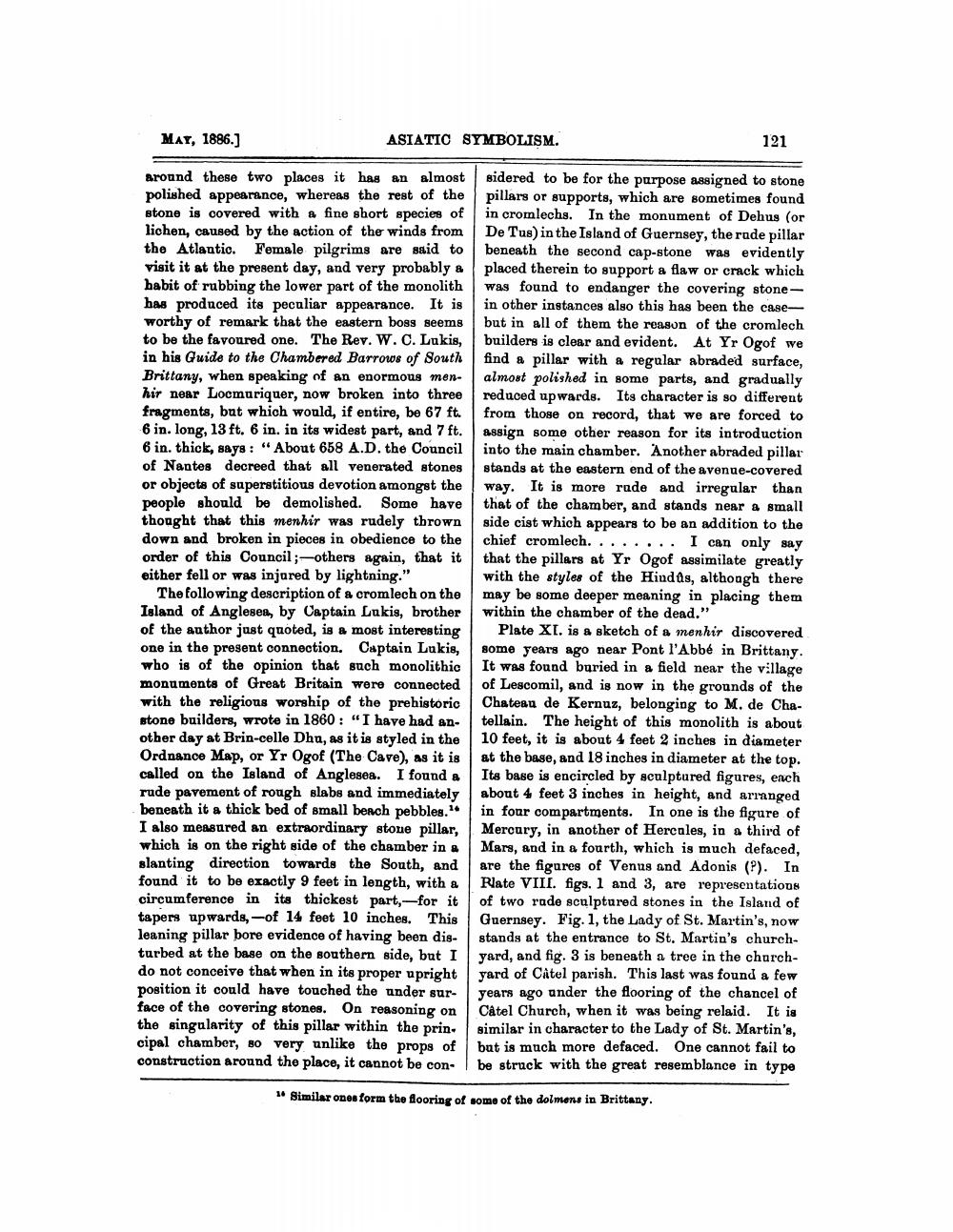________________
MAY, 1886.]
around these two places it has an almost polished appearance, whereas the rest of the stone is covered with a fine short species of lichen, caused by the action of the winds from the Atlantic. Female pilgrims are said to visit it at the present day, and very probably a habit of rubbing the lower part of the monolith has produced its peculiar appearance. It is worthy of remark that the eastern boss seems to be the favoured one. The Rev. W. C. Lukis, in his Guide to the Chambered Barrows of South Brittany, when speaking of an enormous menhir near Locmuriquer, now broken into three fragments, but which would, if entire, be 67 ft. 6 in. long, 13 ft. 6 in. in its widest part, and 7 ft. 6 in. thick, says: "About 658 A.D. the Council of Nantes decreed that all venerated stones or objects of superstitious devotion amongst the people should be demolished. Some have thought that this menhir was rudely thrown down and broken in pieces in obedience to the order of this Council; others again, that it either fell or was injured by lightning."
The following description of a cromlech on the Island of Anglesea, by Captain Lukis, brother of the author just quoted, is a most interesting one in the present connection. Captain Lukis, who is of the opinion that such monolithic monuments of Great Britain were connected with the religious worship of the prehistoric stone builders, wrote in 1860: "I have had another day at Brin-celle Dhu, as it is styled in the Ordnance Map, or Yr Ogof (The Cave), as it is called on the Island of Anglesea. I found a rude pavement of rough slabs and immediately beneath it a thick bed of small beach pebbles. I also measured an extraordinary stone pillar, which is on the right side of the chamber in a slanting direction towards the South, and found it to be exactly 9 feet in length, with a circumference in its thickest part,-for it tapers upwards, -of 14 feet 10 inches. This leaning pillar bore evidence of having been disturbed at the base on the southern side, but I do not conceive that when in its proper upright position it could have touched the under surface of the covering stones. On reasoning on the singularity of this pillar within the prin. cipal chamber, so very unlike the props of construction around the place, it cannot be con
ASIATIC SYMBOLISM.
121
sidered to be for the purpose assigned to stone pillars or supports, which are sometimes found in cromlechs. In the monument of Dehus (or De Tus) in the Island of Guernsey, the rude pillar beneath the second cap-stone was evidently placed therein to support a flaw or crack which was found to endanger the covering stonein other instances also this has been the casebut in all of them the reason of the cromlech builders is clear and evident. At Yr Ogof we find a pillar with a regular abraded surface, almost polished in some parts, and gradually reduced upwards. Its character is so different from those on record, that we are forced to assign some other reason for its introduction into the main chamber. Another abraded pillar stands at the eastern end of the avenue-covered way. It is more rude and irregular than that of the chamber, and stands near a small side cist which appears to be an addition to the chief cromlech.. ... I can only say that the pillars at Yr Ogof assimilate greatly with the styles of the Hindus, although there may be some deeper meaning in placing them within the chamber of the dead."
Plate XI. is a sketch of a menhir discovered. some years ago near Pont l'Abbé in Brittany. It was found buried in a field near the village of Lescomil, and is now in the grounds of the Chateau de Kernuz, belonging to M. de Chatellain. The height of this monolith is about 10 feet, it is about 4 feet 2 inches in diameter at the base, and 18 inches in diameter at the top. Its base is encircled by sculptured figures, each about 4 feet 3 inches in height, and arranged in four compartments. In one is the figure of Mercury, in another of Hercules, in a third of Mars, and in a fourth, which is much defaced, are the figures of Venus and Adonis (?). In Plate VIII. figs. 1 and 3, are representations of two rade sculptured stones in the Island of Guernsey. Fig. 1, the Lady of St. Martin's, now stands at the entrance to St. Martin's churchyard, and fig. 3 is beneath a tree in the churchyard of Câtel parish. This last was found a few years ago under the flooring of the chancel of Câtel Church, when it was being relaid. It is similar in character to the Lady of St. Martin's, but is much more defaced. One cannot fail to be struck with the great resemblance in type
1. Similar ones form the flooring of some of the dolmens in Brittany.




